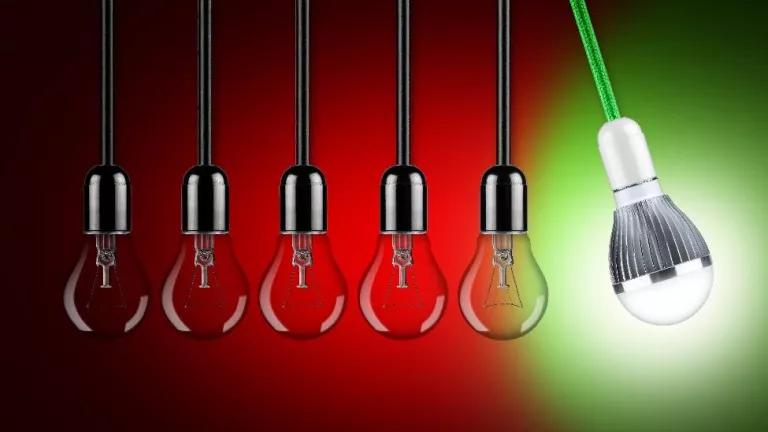Time to Change Our Clocks Back and Our Lightbulbs Forward

Join NRDC’s #LEDchallenge
While the end of Daylight Savings Time this weekend means our lights will be on longer, our energy costs don’t have to go up. In fact, a modest investment in the most energy efficient lightbulbs—LEDs—can help keep our utility bills down all year round. If every U.S. household replaced just one old bulb with an LED, our nation’s electric bill would be cut by more than $5 billion and we’d avoid 2 million metric tons of carbon dioxide pollution—in just 10 years. The savings opportunity is huge because the average U.S. household has around 40 lighting sockets and more than 2 billion sockets nationwide still contain inefficient bulbs.
Few actions can reduce the dangerous carbon pollution driving climate change as cheaply and easily as the simple act of installing more energy-efficient light bulbs in place of the current incandescents still wasting energy in billions of light sockets across America. When we use bulbs that consume less energy, we avoid the need to burn fossil fuels to keep them working.
That’s also why the Natural Resources Defense Council is launching an #LEDchallenge on social media to urge everyone to switch out at least one inefficient bulb for an LED—and asking everyone to “tag” a friend on Facebook, Twitter, and/or Instagram to do the same.
When we roll back our clocks an hour on Sunday (Nov. 5), we’ll be joining more than 70 countries that participate in the annual adjustment to end Daylight Savings Time. Given that we’ll need to keep the lights on longer each day, it’s a great time to upgrade to more efficient bulbs.
Why LEDs?
Modern technology has dramatically improved the lifespan of the modern lightbulb (LEDs can last as long as 25 years under normal use of 3 hours per day) even while substantially decreasing the actual amount of energy needed to light up our lives.
And the cost of these new and improved bulbs has steadily come down (LEDs that just a few years ago cost as much as $20 are typically down below $5, and often can be found for $2 per bulb when purchased in a multi-pack). As a result, LED lightbulbs have grown from just 1 percent of the market a few years ago to more than 25 percent of all bulbs sold today, with additional increases expected as LED prices continue to decline.
Unsure which LED version to buy for your home? Check out our new lighting guide.
The brighter idea
Credit the U.S. Congress and President George W. Bush with recognizing that the old, wasteful incandescent lightbulb had not changed much from the version that Thomas Edison’s researchers developed in Menlo Park, N.J., in the late 1800s. The Bush administration realized that setting energy efficiency standards for bulbs and gradually phasing them in over a period of years could shear billions of dollars off the cost of consumer electric bills.
The first step in implementing the new standards took place between 2012 and 2014 when improved incandescent and halogen bulbs began replacing regular incandescents in stores across the country. Those new bulbs alone used 28 percent less energy than their predecessors. The next step is due to go into effect in 2020 when all lightbulbs used for general illumination must achieve 45 lumens per watt, which is more than triple the efficiency of the old incandescents, and which all LEDs already meet today.
Once the two-decade-long transition to more efficient bulbs is completed, consumers will save more than $10 billion on their electric bills every year. And it gets better: A side benefit of that monetary savings is a reduction in the total amount of energy needed to light up America. That savings alone translates to avoiding the annual electricity output of 30 large (500-megawatt) coal burning power plants—and their associated pollution.
Higher standards are better for everyone
The drive to more efficient lightbulbs—with lower costs to buy, lower costs to operate, and lower energy needs that reduce pollution, is truly an across-the-board “win” for our country and the environment. The manufacturing of improved incandescent and halogen bulbs sold in America largely takes place in factories in Mexico, China, and Hungary. However, several thousand jobs have been created in the United States in the research, design, manufacturing, and marketing of LED bulbs and related products, which dwarfs the number of remaining domestic jobs tied to incandescent bulbs. For example:

- Cree Inc., based in North Carolina and Wisconsin, employs more than 3,000 people in the development and production of LEDs.
- Lumileds, which makes LEDs that go into household lightbulbs and car headlights, is based in San Jose, CA.
- Ledvance, the maker of Sylvania light bulbs, has retooled its Saint Marys, PA factory from producing halogen and incandescent light bulbs to the state of the art, super-efficient LED light bulbs. As a result, the 200 current manufacturing jobs will be preserved and per Ledvance another 20 jobs will be added.
Join our #LEDchallenge and urge your friends and neighbors to do the same. Pick up a four-pack of new shiny LED lightbulbs and you'll save a bunch of money, avoid the hassle and cost of having to change the bulb every year, and help the environment, too.



